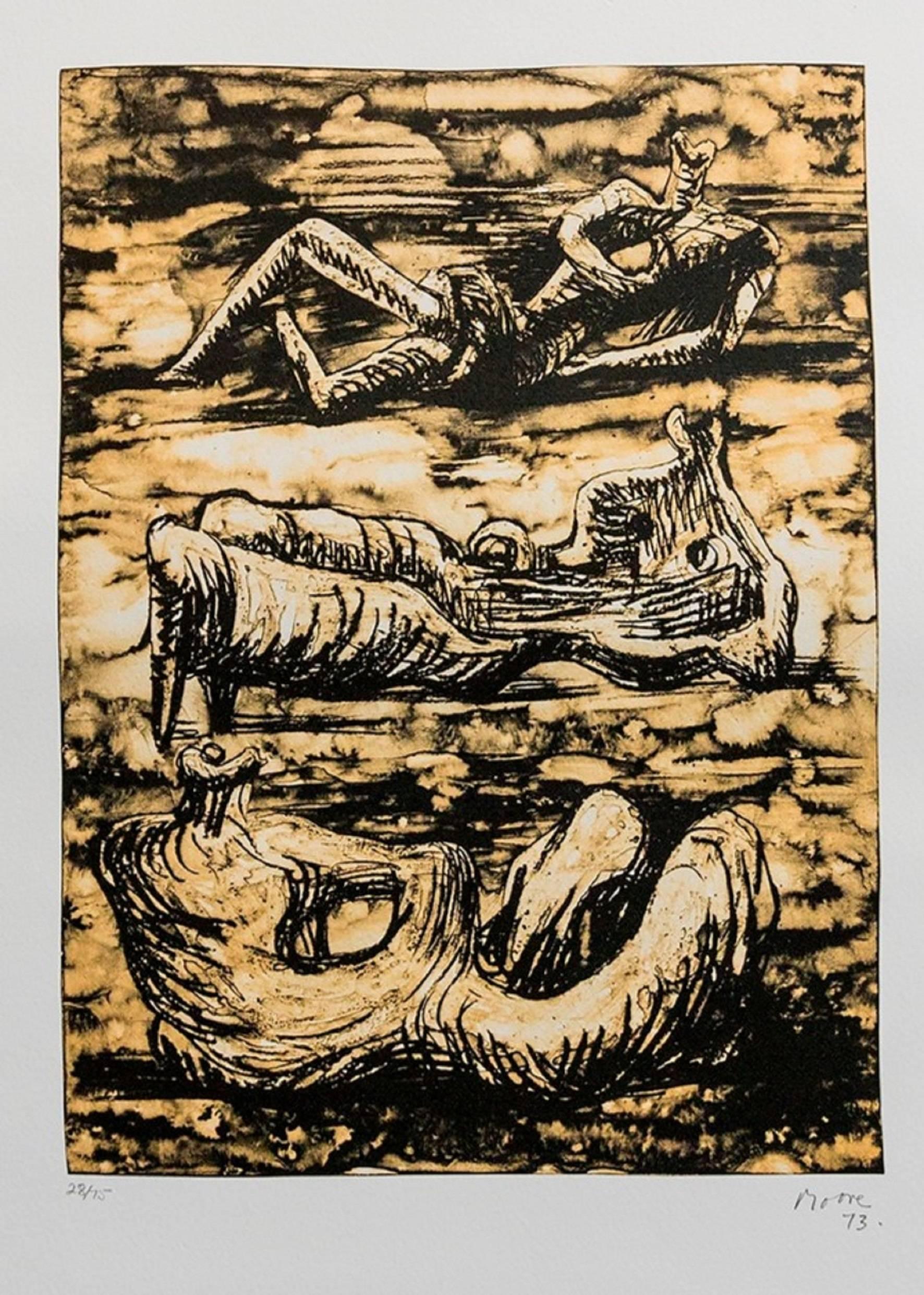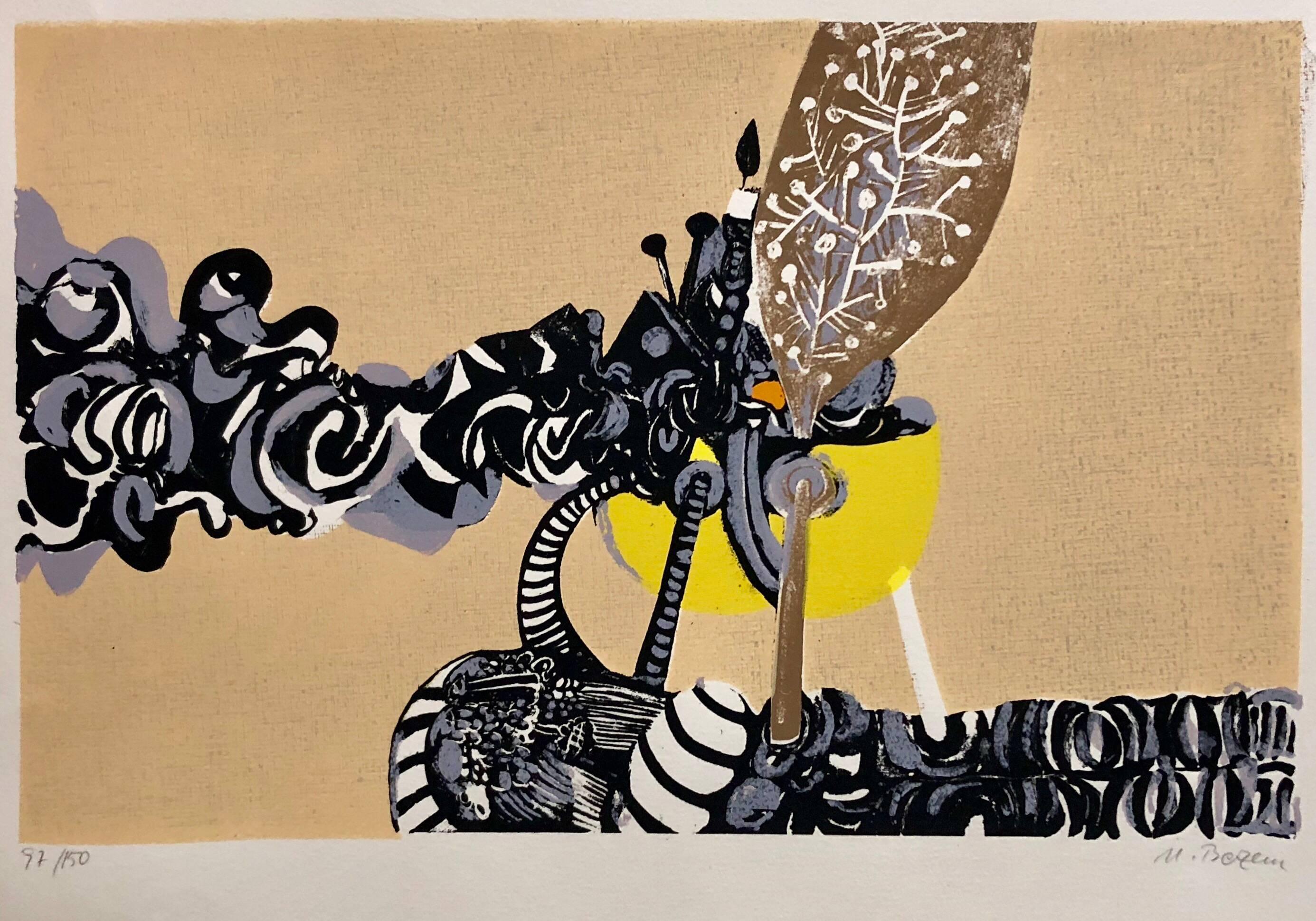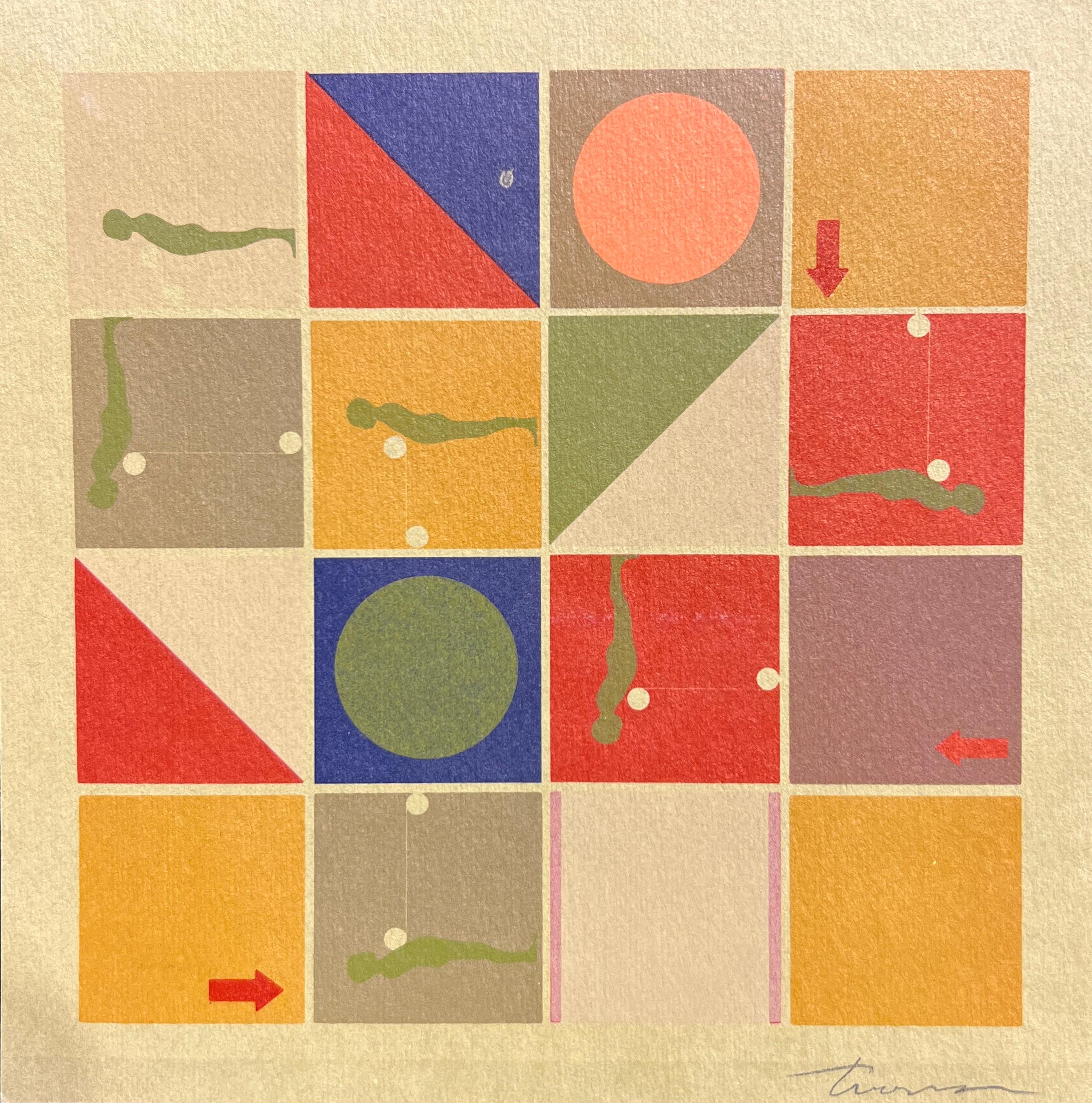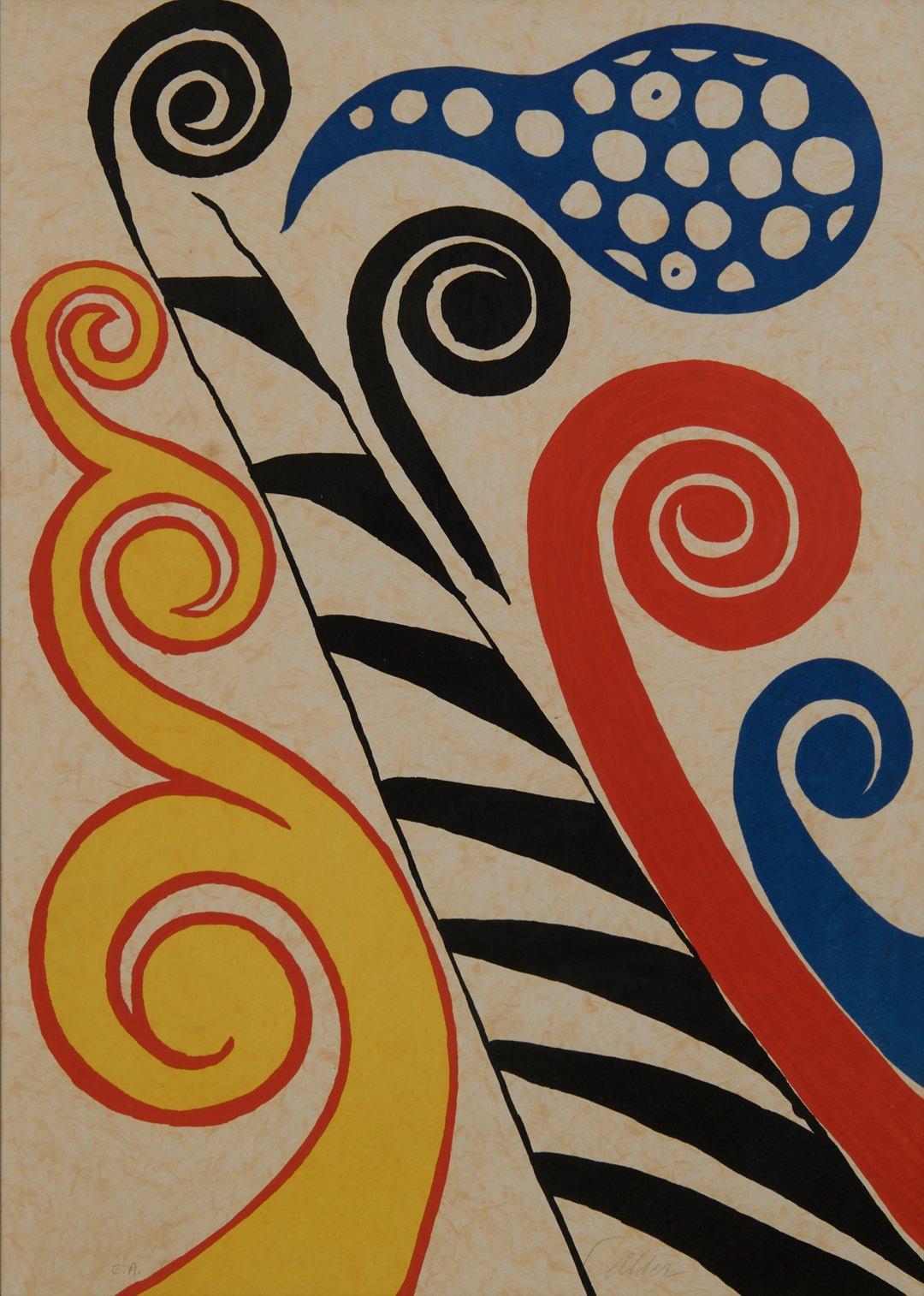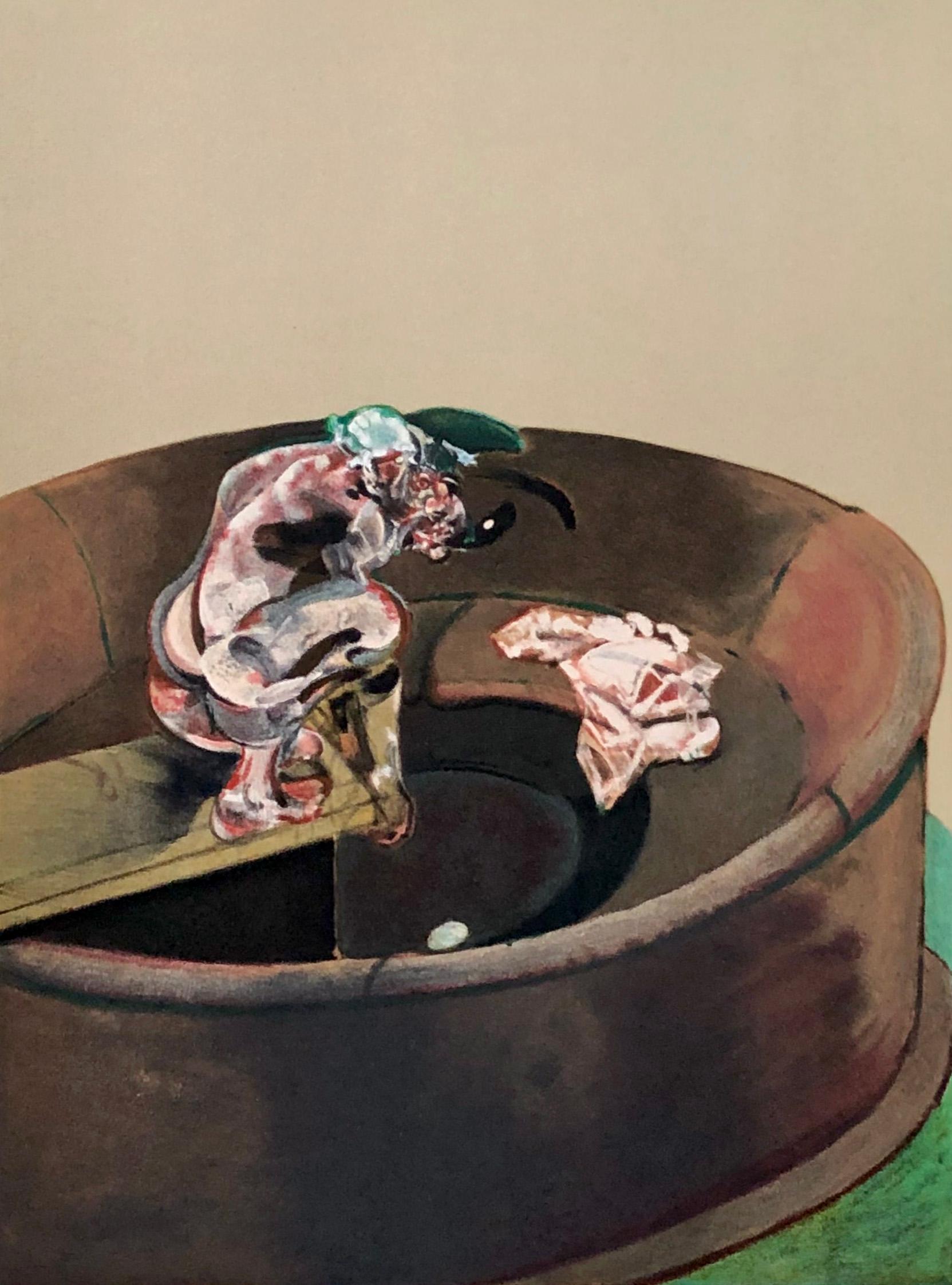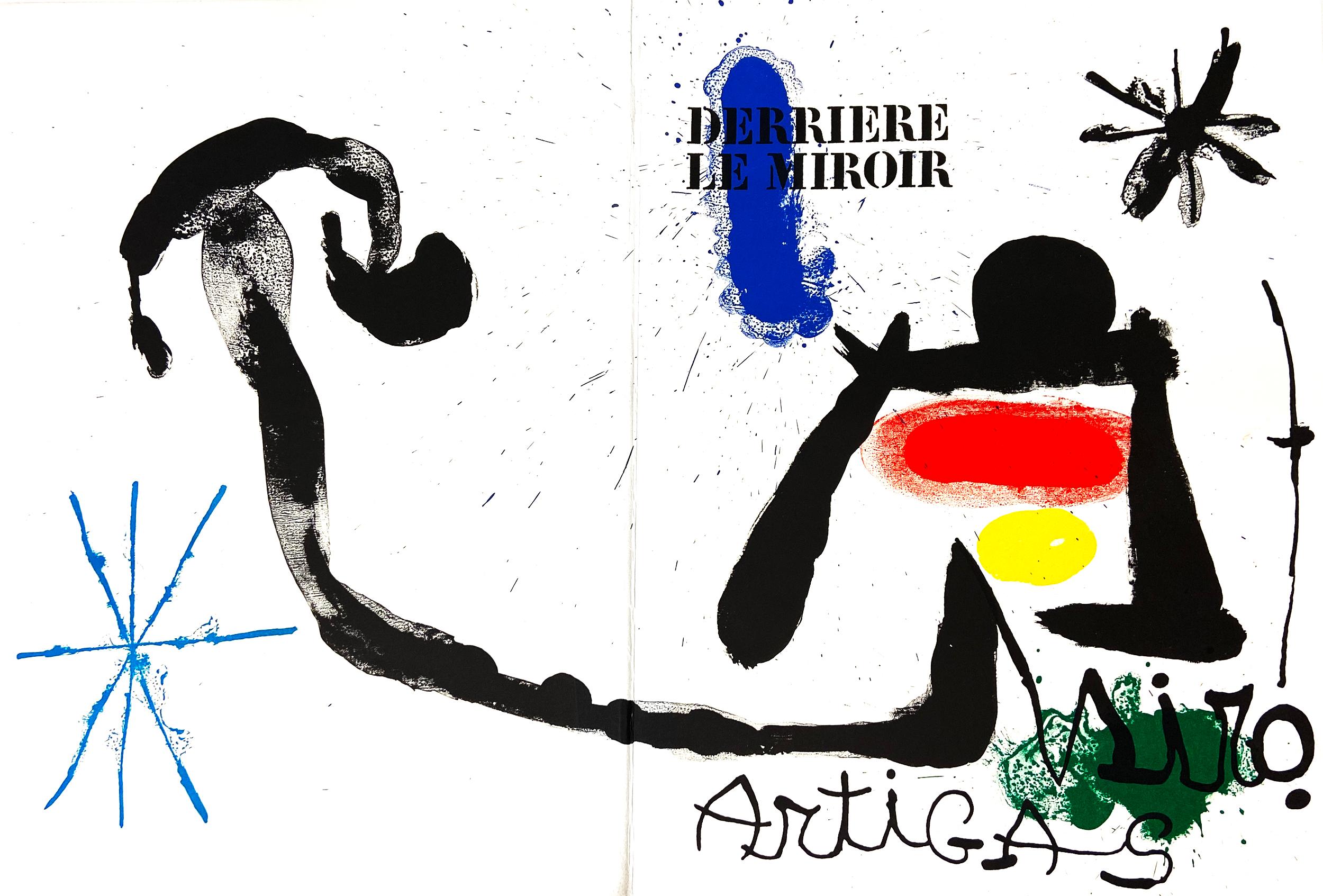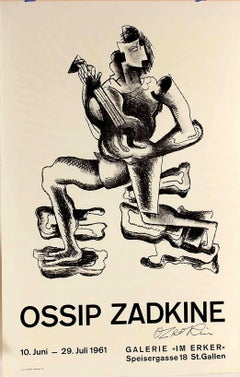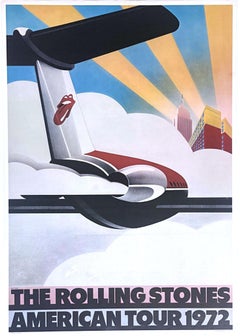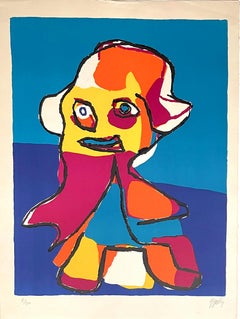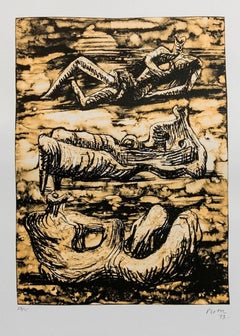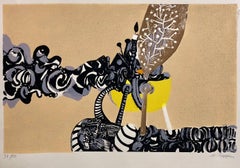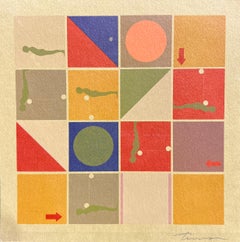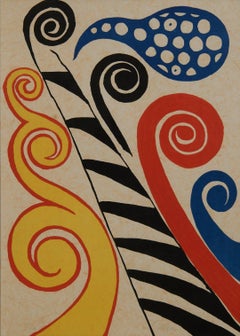Items Similar to Head, Lithograph from the Swiss Society of Arts Portfolio (Lutze 629), Signed/N
Want more images or videos?
Request additional images or videos from the seller
1 of 8
Horst AntesHead, Lithograph from the Swiss Society of Arts Portfolio (Lutze 629), Signed/N1975
1975
About the Item
Horst Antes
Untitled, from the Swiss Society of Arts Portfolio (Lutze 629), 1975
Lithograph on paper with Deckled Edges.
Hand signed and numbered 26/200 by the artist on the front
26 × 19 3/4 inches
Unframed
This whimsical print by Horst Antes was chosen to be included in the 1975 portfolio for the Swiss Society for Fine Arts (Grafikmappe des Schweizerischen Kunstvereins) as part of an international portfolio of prints by many other world renowned artists. Hand signed and numbered from the edition of 200. This work is quite rare, especially stateside.
Catalogue Raisonne reference: Lutze 629
Horst Antes Biography
Horst Antes was born in Heppenheim an der Bergstrasse on October 28, 1936. From 1957 to 1959 he studied at the State Academy of Fine Arts in Karlsruhe under HAP Grieshaber. At the age of 23, the young artist was awarded the prize of the Hanoverian economy (Pankofer Prize, Baden Baden). In 1960 he received a scholarship from the Kulturkreis im Bundesverband der Deutschen Industrie, Cologne. The first head painting in profile “Head with red cap” is created. Horst Antes was awarded the “Junger Westen” art prize and the “Prix des artistes” at the II Biennale des “juenes artistes”, Paris in 1961. After that he lived and worked for one year in Florence with a scholarship from Villa Romana. He then went to Rome for a year to the Villa Massimo. From 1965 to 1968 Horst Antes taught at the State Academy of Fine Arts in Karlsruhe (1967-68 as a visiting professor). In 1966 he participated for the second time in the XXXIII Venice Biennale, received the Unesco Prize for Painting and the second scholarship of the Aldegrever Society, Münster. Horst Antes’ interest in indigenous peoples led him for the first time in 1972 to various Indian reservations in the USA. The Falklands War in 1982 shocked the artist deeply and led to a change in his subjects: the “head figure” disappears from the pictorial work and the first house paintings are created.
- Creator:Horst Antes (1936, German)
- Creation Year:1975
- Dimensions:Height: 26 in (66.04 cm)Width: 19.75 in (50.17 cm)
- Medium:
- Movement & Style:
- Period:
- Condition:
- Gallery Location:New York, NY
- Reference Number:1stDibs: LU1745212596062
Horst Antes
Horst Antes (born 28 October 1936 Heppenheim, Germany) is a German artist and sculptor. After his Abitur, he studied from 1957 to 1959 under the important woodcutter HAP Grieshaber at the Akademie der Bildenden Künste (today known as the Staatliche Akademie der Bildenden Künste Karlsruhe) in Karlsruhe. In 1959, the artist's work was honoured with two prizes, art prize of the city of Hanover and the Pankofer prize on the occasion of the German Youth Art prize. In his early paintings, Antes sought a path somewhere between figurative painting and the L'Art Informel. One of his most important role models was Willem de Kooning. Around 1960 Antes discovered his 'Kopffüßler' (literal translation: Head-Footer), a form which preoccupied the artist in numerous variations and artistic techniques. By 1963 his 'Kopffüßler' was fully developed in its stylistic and contextual premises and became also compulsory for his sculptural work, which began the same year. The artist was given several scholarships and awards in the 1960s, including the Villa-Romana-Prize in Florence in 1962 and the Villa Massimo scholarship in Rome in 1963. Three years later, aged only 29, Antes accepted a teaching post at the Akademie in Karlsruhe. This was followed by a post as a professor also in Karlsruhe which he held from 1967 to 1973, as well as a one-year guest-professorship at the Staatliche Hochschule für Bildende Künste in Berlin. The artist resumed teaching at the Akademie in Karlsruhe in 1984 and continued teaching there for another 16 years. The regional capital awarded him the Hans-Molfenter-prize in 1989. Since 1990 Antes has been living and working in Karlsruhe, Florence and Berlin. His oeuvre includes not only paintings and graphic art, but also sculptures in public spaces. His works are exhibited throughout the world and are represented in all the most important German collections, et al. at the Kunsthall Hamburg, the Museum Ludwig in Cologne, the Nationalgalerie Berlin, and the Museum of Modern Art.
About the Seller
5.0
Platinum Seller
Premium sellers with a 4.7+ rating and 24-hour response times
Established in 2007
1stDibs seller since 2022
408 sales on 1stDibs
Typical response time: 1 hour
- ShippingRetrieving quote...Shipping from: New York, NY
- Return Policy
Authenticity Guarantee
In the unlikely event there’s an issue with an item’s authenticity, contact us within 1 year for a full refund. DetailsMoney-Back Guarantee
If your item is not as described, is damaged in transit, or does not arrive, contact us within 7 days for a full refund. Details24-Hour Cancellation
You have a 24-hour grace period in which to reconsider your purchase, with no questions asked.Vetted Professional Sellers
Our world-class sellers must adhere to strict standards for service and quality, maintaining the integrity of our listings.Price-Match Guarantee
If you find that a seller listed the same item for a lower price elsewhere, we’ll match it.Trusted Global Delivery
Our best-in-class carrier network provides specialized shipping options worldwide, including custom delivery.More From This Seller
View AllRare 1960s Galerie Im Erker Exhibition poster (Hand Signed by Ossip Zadkine)
By Ossip Zadkine
Located in New York, NY
Ossip Zadkine
Galerie Im Erker Exhibition (Hand Signed), 1961
Off-set Lithograph Poster (Signed by Zadkine)
Signed in ink on lower right front
33 1/2 × 21 1/2 inches
Unframed
Provena...
Category
1960s Modern Abstract Prints
Materials
Lithograph, Offset
Rolling Stones American Tour, rare original 1972 poster designed by John Pasche
By John Pasche
Located in New York, NY
John Pasche
Rolling Stones American Tour, original 1972 poster, 1972
Original vintage offset lithograph poster (this is the original poster, not a reprint
35 1/2 × 25 inches
Unframed...
Category
1970s Modern Figurative Prints
Materials
Lithograph, Offset
Karel Appel, Little Boy, color lithograph, hand signed and numbered COBRA artist
By Karel Appel
Located in New York, NY
"Little Boy" - charming 1960s silkscreen rarely seen on the market would look perfect in a child's room - or in any room in the house!
Karel Appel
Little ...
Category
1960s Modern Abstract Prints
Materials
Lithograph
Window on Another Dimension, signed/n lithograph by Picasso's famous mistress
By Françoise Gilot
Located in New York, NY
Françoise Gilot
Window on Another Dimension, 1981
Lithograph on Arches mould made Johannot paper
Signed and numbered in graphite pencil; also bears artist's monogram with date, edition of 60
Frame included: floated in the original vintage frame
Measurements:
Framed
30 inches vertical by 22 inches horizontal by .75 inches depth
Artwork:
27.25 inches by 19.75 inches
Francoise Gilot was not just Picasso's muse; she was an accomplished artist in her own right, and at age 100, the New York Times dubbed her the art world's latest "It Girl".! Signed and numbered in graphite pencil; also bears artist's personal monograph with date. Held in original vintage frame under plexiglass. Charmingly, there is a sticker label on the back of the frame, from the "Picasso Gallery Custom Framing" in D.C.
This silkscreen is based upon Gilot's eponymous painting, also done in 1981
Excerpt from Alan Riding's 2023 New York Times obituary on Gilot:
" Françoise Gilot, an accomplished painter whose art was eclipsed by her long and stormy romantic relationship with a much older Pablo Picasso, and who alone among his many mistresses walked out on him, died on Tuesday at a hospital in Manhattan. She was 101...But unlike his two wives and other mistresses, Ms. Gilot rebuilt her life after she ended the relationship, in 1953, almost a decade after it had begun despite an age difference of 40 years. She continued painting and exhibiting her work and wrote books. In 1970, she married Jonas Salk, the American medical researcher who developed the first safe polio vaccine, and lived part of the time in California. Still, it was for her romance with Picasso that the public knew her best, particularly after her memoir, “Life with Picasso,” written with Carlton Lake, was published in 1964. It became an international best seller, and so infuriated Picasso that he broke off all contact with Ms. Gilot and their two children, Claude and Paloma Picasso. Ms. Gilot’s frank and often-sympathetic account of their relationship — she dedicated the book “to Pablo” — provided much of the material for the 1996 Merchant-Ivory movie, “Surviving Picasso,” in which she was played by Natascha McElhone, with Anthony Hopkins as Picasso.
If Ms. Gilot’s book sold well, so has her art. With her work in more than a dozen museums, including the Metropolitan Museum of Art and the Museum of Modern Art in New York and the Centre Pompidou in Paris, her paintings fetched increasingly higher prices well into her later years.
As recently as June 2021, her painting “Paloma à la Guitare” (1965), a blue-toned portrait of her daughter, sold for $1.3 million in an online auction by Sotheby’s. That surpassed her previous record price, $695,000, paid for “Étude bleue,” a 1953 portrait of a seated woman, at a Sotheby’s auction in 2014.. And in November 2021, her abstract 1977 canvas “Living Forest” sold for $1.3 million as part of a retrospective of her work at Christie’s in Hong Kong. Lisa Stevenson, the head of curated sales for Sotheby’s in London, told ARTnews after the 2021 auction, “It isn’t commonly known that Gilot’s commitment to art was present long before her relationship with Pablo Picasso, and she was sadly often left in his shadow.”..
Marie Françoise Gilot was born into a prosperous family on Nov. 26, 1921, in Neuilly-sur-Seine, a suburb of Paris, the only child of Emile Gilot, an agronomist and chemical manufacturer, and Madeleine Renoult-Gilot. Her 19th-century ancestors had owned a couturier house of fashion whose clientele included Eugenia, the wife of Emperor Napoleon III. Marie Françoise was drawn to art from an early age, tutored by her mother, who had studied art history, ceramics and watercolor painting. Her father, however — recalled by Ms. Gilot as an authoritarian who had forced her to write with her right hand, though she was left-handed — had other ideas. Envisioning a career in science or the law for his daughter, he persuaded her to enroll at the University of Paris, where she received her bachelor’s degree in 1938 at age 17. She went on to study at the Sorbonne and the British Institute in Paris and receive a degree in English literature from Cambridge University. As war crept closer to France in 1939, her father sent her to the city of Rennes, northwest of Paris, to enroll in law school. All the while she continued working on her paintings. Then came the German occupation of Paris, in June 1940, and she joined other students in an anti-German protest march at the Arc de Triomphe. In a clash with the French and German authorities, Ms. Gilot was arrested, briefly detained and put under watch. “From day one, we were not the kind of people who would become collaborators,” she said of her family.
She continued her law studies at the University of Paris, but after taking her second-year examinations, in June 1941, she lost interest and abandoned the field, deciding to devote herself to art. She began private lessons with a fugitive Hungarian Jewish painter, Endre Rozsda, and attended classes at the Académie Julian, which numbered Matisse...
Category
1980s Modern Abstract Prints
Materials
Lithograph
Sam's Art, from the New York International portfolio, signed/n lithograph 1966
By Saul Steinberg
Located in New York, NY
Saul Steinberg
Sam's Art, from The New York International Portfolio), 1966
Lithograph on wove paper with blind stamp
Pencil signed and numbered 12/225 on the front
Published by Tanglewood Press, Knickerbocker Machine and Foundry, Inc., New York
Printed by Irwin Hollander with blind stamp
Unframed
This Steinberg lithograph is titled Sam's Art, which of course refers to Uncle Sam, the nickname for the United States government. It features his version of the motto seen on our dollar bills, "Annuit Coeptis", which is one of the mottoes found on the Great Seal of the United States. It is directly underneath the "Eye of Providence" and is translated by the US Treasury and State Department as "God (or Providence) favors our undertakings". American President Abraham Lincoln, sitting in front of an easel, is also depicted as an artist in this telling 1960s work.
Commentary:
"In Saul Steinberg’s lithograph ‘Sam’s Art’, Abraham Lincoln, in stove-pipe hat, poses as the artist in front of his canvas. While his attention looks fixed on rendering the slightly wobbly pyramid with an eye, the Masonic motif from the back of the one dollar bill, the line from his brush has floated off the canvas to become a cubist-futurist cloud in the sky. The American Eagle looks on, perched on a civil war cannon...
Category
1960s Modern Abstract Prints
Materials
Lithograph
Flag - rare lt. ed. lithograph by renowned Brazilian born sculptor signed 18/100
By Saint Clair Cemin
Located in New York, NY
Saint Clair Cemin
FLAG, 1978
Lithograph on blind stamped paper
25 × 35 inches
Pencil signed and numbered 18/100
Unframed
Rare vintage lithograph by this renowned Brazilian-born inter...
Category
1970s Abstract Abstract Prints
Materials
Lithograph, Pencil
You May Also Like
Henry Moore 1973 Lithograph edition 28/75 Sculpture Figures Reclining Nudes
By Henry Moore
Located in Surfside, FL
Henry Spencer Moore (1898 – 1986)
Moore was born in Castleford, the son of a coal miner. He became well-known through his carved marble and larger-scale abstract cast bronze sculptures, and was instrumental in introducing a particular form of modernism to the United Kingdom later endowing the Henry Moore Foundation, which continues to support education and promotion of the arts.
After the Great War, Moore received an ex-serviceman's grant to continue his education and in 1919 he became a student at the Leeds School of Art (now Leeds College of Art), which set up a sculpture studio especially for him. At the college, he met Barbara Hepworth, a fellow student who would also become a well-known British sculptor, and began a friendship and gentle professional rivalry that lasted for many years. In Leeds, Moore also had access to the modernist works in the collection of Sir Michael Sadler, the University Vice-Chancellor, which had a pronounced effect on his development. In 1921, Moore won a scholarship to study at the Royal College of Art in London, along with Hepworth and other Yorkshire contemporaries. While in London, Moore extended his knowledge of primitive art and sculpture, studying the ethnographic collections at the Victoria and Albert Museum and the British Museum.
Moore's familiarity with primitivism and the influence of sculptors such as Constantin Brâncuși, Jacob Epstein, Henri Gaudier-Brzeska and Frank Dobson led him to the method of direct carving, in which imperfections in the material and marks left by tools became part of the finished sculpture. After Moore married, the couple moved to a studio in Hampstead at 11a Parkhill Road NW3, joining a small colony of avant-garde artists who were taking root there. Shortly afterward, Hepworth and her second husband Ben Nicholson moved into a studio around the corner from Moore, while Naum Gabo, Roland Penrose, Cecil Stephenson and the art critic Herbert Read also lived in the area (Read referred to the area as "a nest of gentle artists"). This led to a rapid cross-fertilization of ideas that Read would publicise, helping to raise Moore's public profile. The area was also a stopping-off point for many refugee artists, architects and designers from continental Europe en route to America—some of whom would later commission works from Moore.
In 1932, after six year's teaching at the Royal College, Moore took up a post as the Head of the Department of Sculpture at the Chelsea School of Art. Artistically, Moore, Hepworth and other members of The Seven and Five Society would develop steadily more abstract work, partly influenced by their frequent trips to Paris and their contact with leading progressive artists, notably Pablo Picasso, Georges Braque, Jean Arp and Alberto Giacometti. Moore flirted with Surrealism, joining Paul Nash's modern art movement "Unit One", in 1933. In 1934, Moore visited Spain; he visited the cave of Altamira (which he described as the "Royal Academy of Cave Painting"), Madrid, Toledo and Pamplona. Moore made his first visit to America when a retrospective exhibition of his work opened at the Museum of Modern Art in New York City.[28]
Before the war, Moore had been approached by educator Henry Morris, who was trying to reform education with his concept of the Village College. Morris had engaged Walter Gropius as the architect for his second village college at Impington near Cambridge, and he wanted Moore to design a major public sculpture for the site.
In the 1950s, Moore began to receive increasingly significant commissions. He exhibited Reclining Figure: Festival at the Festival of Britain in 1951, and in 1958 produced a large marble reclining figure for the UNESCO building in Paris. With many more public works of art, the scale of Moore's sculptures grew significantly and he started to employ an increasing number of assistants to work with him at Much Hadham, including Anthony Caro and Richard Wentworth.
Moore produced at least three significant examples of architectural sculpture during his career. In 1928, despite his own self-described extreme reservations, he accepted his first public commission for West Wind for the London Underground Building at 55 Broadway in London, joining the company of Jacob Epstein and Eric Gill..At an introductory speech in New York City for an exhibition of one of the finest modernist sculptors, Alberto Giacometti, Sartre spoke of The beginning and the end of history...
Category
1970s Modern Abstract Prints
Materials
Lithograph
Rare Israeli Surrealist Judaica Abstract Lithograph Naftali Bezem
By Naftali Bezem
Located in Surfside, FL
Fine lithograph on deckle edged French Arches paper. Pencil signed and numbered from edition of 150.
A Surrealist Judaica scene of a bearded man (Rabbi) in a boat with Shabbat candlesticks. with blindstamp from Editions Empreinte in Paris, France. (They published, Jean Michel Folon, Sempe, Raoul Ubac, Raymond Savignac, Cesar, Bengt Lindstrom , Paul Aizpiri and many other modern masters.
Naftali Bezem (Hebrew: נפתלי בזם; born November 27, 1924) is an Israeli painter, muralist, and sculptor.
Bezem was born in Essen, Germany, in 1924. His early adolescence was spent under Nazi oppression, in constant fear for the safety of his parents, who perished in the Holocaust in the Polish Auschwitz concentration camp. Naftali emigrated to Mandate Palestine in 1939, at the age of fourteen with a Youth Aliyah group.
From 1943 to 1946, he studied art at the Bezalel Academy of Art and Design in Jerusalem with Israeli painter Mordecai Ardon. He then spent three years studying in Paris.His most famous public works include a wall relief at Yad Vashem in Jerusalem and the ceiling mural in the main reception room at the President's Residence, Jerusalem.In 1957, Bezem was a co-recipient of the Dizengoff Prize for Painting.
Group Exhibitions
Orit Art Gallery, Tel Aviv
Artists: Yosef Zaritsky, Marcel Janco, Lea Nikel, Robert Baser, Bezem, Michael Druks,
Israeli Painting (Watercolors and Gouache)
Artists:
Pinchas Abramovich, Bezem, Naftali Nachum Gutman, Haim Gliksberg, Mordechai Levanon, Avigdor Stematsky, Avshalom Okashi, Yehiel Krize...
Category
20th Century Modern Figurative Prints
Materials
Lithograph
Study/Falling Man (Series I)
By Ernest Tino Trova
Located in Missouri, MO
Study/Falling Man (Series I), 1967
By. Ernest Tino Trova (American, 1927-2009)
Black Frame, Green Background
Signed in Pencil Lower Right
Unframed: 6 x 6 inches
With Frame: 8.75 x 8....
Category
20th Century American Modern Abstract Prints
Materials
Lithograph
Price Upon Request
Fiesta, c. 1973, red, yellow & blue figurative abstract lithograph
By Alexander Calder
Located in Beachwood, OH
Alexander Calder (American, 1898-1976)
Fiesta, c. 1973
Lithograph in colors
Signed lower right
Edition: E. A.
20 x 28 inches
35.5 x 37.75 inches, framed
One of America's best known ...
Category
1970s Modern Abstract Prints
Materials
Lithograph
1960s Francis Bacon lithograph (from derrière le miroir)
By (after) Francis Bacon
Located in NEW YORK, NY
1960s Francis Bacon lithograph from Derrière le miroir:
Well-suited for matting & framing, this original 1960's print is derived from Bacon's ...
Category
1960s Modern Abstract Prints
Materials
Lithograph
$520 Sale Price
20% Off
1960's Joan Miro lithograph (from Derrière le miroir)
By Joan Miró
Located in NEW YORK, NY
1960s Joan Miró lithograohic cover from Derrière le miroir:
Lithographic cover in colors; 11 x 15 inches (folding out to 15 x 22 inches). Circa 1964.
Very good overall vintage cond...
Category
1970s Modern Figurative Prints
Materials
Lithograph
$260 Sale Price
20% Off
